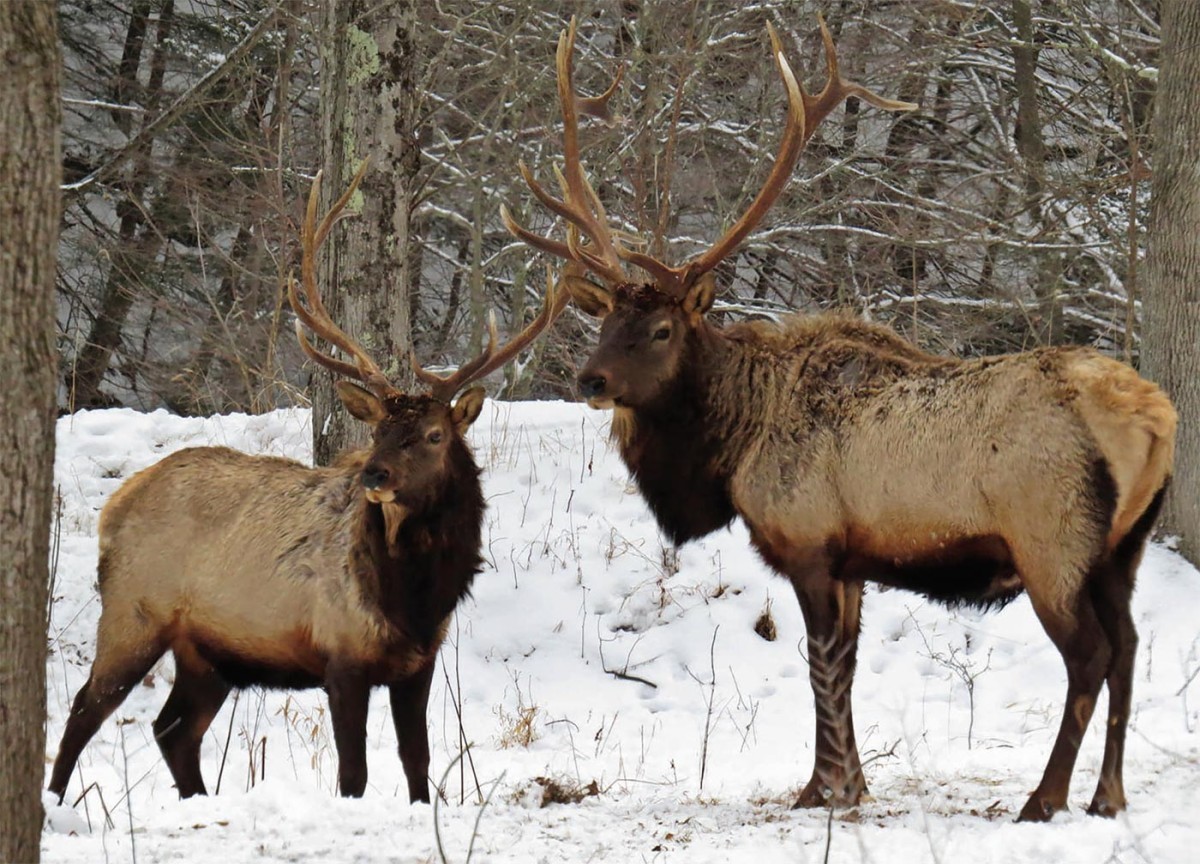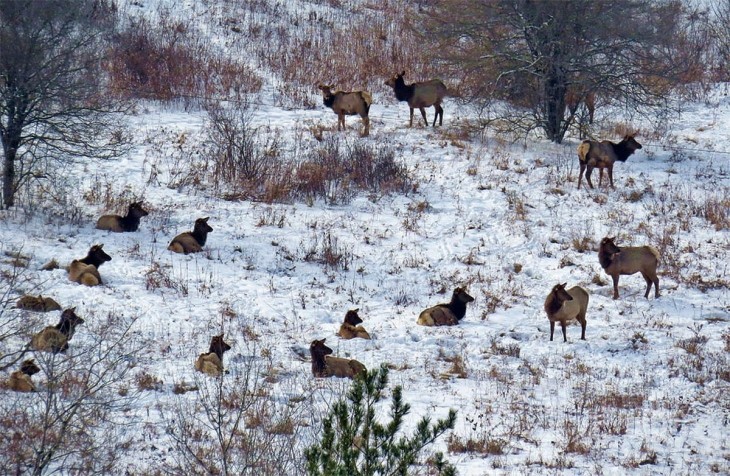
Take a walk through the wooded mountains of North Central Pennsylvania and you may catch a glimpse of a magnificent animal, previously extirpated in the state. Throughout a 3,500-square-mile area, Pennsylvania’s elk herd is thriving. The existence of a large, free-ranging elk herd in the eastern United States, well over 1,000 strong, is truly a wildlife success story.
Native Americans called them “wapiti,” a Shawnee word meaning “white deer,” a reference to the elk’s beige coat and cream-colored rump patches. Adult bulls stand four to five feet at the shoulder, sport massive antlers, and weigh as much as 1,000 pounds. Females are somewhat smaller, averaging between 500 and 600 pounds. Eastern elk (Cervus canadensis canadensis), a subspecies that inhabited the northern and eastern United States, were once abundant throughout their range. Elk numbers dwindled significantly after the arrival of white settlers, however, and by 1850, overhunting and habitat destruction had reduced the elk population east of the Mississippi River to only a few scattered herds. One of those remaining groups resided in the thickly forested Allegheny Mountains of central Pennsylvania. The last native elk in the state was killed around 1867, and the U.S. Fish & Wildlife Service declared the eastern subspecies extinct in 1880.
Fortunately for elk the story does not end there. The establishment of the Pennsylvania Game Commission (PGC) in 1895 set the stage for an ambitious effort to restore several of the state’s dangerously low or extirpated wildlife populations. In 1912, Joseph Kalbfus, executive secretary of the Game Commission, proposed the idea of reintroducing elk in Pennsylvania. Between 1913 and 1926, the PGC released 177 elk – transported from the western United States – throughout several counties in the North Central area of the state.
The state’s Elk Management Plan, first implemented in the 1970s, has helped ensure the herd’s survival. The 2020–2025 Elk Management Plan emphasizes creating and maintaining good-quality habitat for an expanding herd, maintaining that herd at sustainable numbers, and implementing strategies designed to minimize elk-human conflicts. In addition, the PGC strives to educate and inform the public about elk management and to provide recreational opportunities including hunting. In partnership with the Keystone Elk Country Alliance, the state maintains the Elk Country Visitor Center in Benezette, featuring educational exhibitions and areas for viewing elk.

Early Challenges to Reintroduction
Since reintroduction, Pennsylvania’s elk herd has faced challenges ranging from overhunting and conflicts with farmers to disease. Initially, the reintroduced elk thrived in their new habitat, and the PGC established a limited hunting season in 1923. That decision was a costly mistake; during the next eight years hunters took 98 bulls, with 78 others killed illegally or for contributing to crop damage. Unable to withstand such high mortality, the herd dwindled. Hunting was discontinued, but the elk population continued to steadily decline, until as few as two dozen elk remained by the late 1940s. For the next 25 years, the restoration project was virtually forgotten.
In the early 1970s, with interest in Pennsylvania’s elk rekindled, the state established an Elk Management Plan through the cooperative efforts of the PGC and the state’s Bureau of Forestry. The Game Commission considered the state’s elk population, at that time the only free-ranging elk in the eastern United States, a valuable public resource that should be maintained for the enjoyment and benefit of all people.
By 1972, PGC estimates indicated a herd size of more than 75 animals, and it appeared the elk population was on the road to recovery. But a few years later, only 40 elk remained. The herd had been decimated by Parelaphostrongylus tenuis, more commonly known as brain worm. White-tailed deer are the common host of this parasitic nematode in the eastern United States and Canada. The white-tail and brain worm evolved together during countless centuries, and brain worm causes only occasional illness in deer. However, white-tails can introduce the parasite to other susceptible species such as elk, which have no evolved defense against it. The resulting infection is often fatal in elk.
Despite a decrease in its numbers, the Pennsylvania elk herd survived and began a slow recovery. By 1980, there were more than 100 elk in the state for the first time since the 1920s, and by 1989, the herd numbered more than 150 animals. Today, there are an estimated 1,400 to 1,500 wild elk in Pennsylvania.
Managing Elk Habitat, Movement, and Genetic Diversity
Pennsylvania’s elk management area presently covers more than 3,700 square miles, with more than 70 percent of that area in public land ownership consisting primarily of state parks and state game lands. The remaining management area is privately owned, and therein lies a potential problem. Elk frequently move between public and private lands, which sometimes leads to farmer-elk confrontations. An adult elk can consume more than 20 pounds of corn and hay in a single day, and a herd of hungry elk can make quick work of a cornfield. Under the state’s Game Law, farmers are permitted to protect their livelihood, and thus can shoot depredating elk.
Unlike deer, which prefer trees and shrubs, elk primarily forage in open meadowlands, eating grasses, sedges, rushes, ferns, and forbs. In an effort to keep elk on public lands and to mitigate agricultural conflicts, the PGC created and maintains slightly more than 2,100 acres of open herbaceous habitat on public lands within the prime elk range.
Jeremy Banfield, PGC wildlife biologist in charge of the Pennsylvania Elk Management Plan, said the PGC does not yet know how many elk Pennsylvania’s wildlands can support and added that number “will be determined by maintaining a balance between the biological carrying capacity and the social carrying capacity.” With ample prime elk habitat in the state, the herd has room to expand. One factor determining how much the herd can grow will be the ability to minimize agricultural conflicts as elk move into areas where they have not lived for more than a half century.
Another concern is the genetic diversity within the herd, said Banfield, who noted Pennsylvania’s elk population has some of the lowest genetic diversity in North America. Poor genetic diversity has been linked to harmful effects in certain wildlife populations, including declines in survival rates and increased susceptibility to disease. While this does not appear to be an issue with the Pennsylvania elk population now, it could pose problems in the future. Biologists also worry about chronic wasting disease (CWD), a fatal brain disease of deer, elk, and related species. Although there is no evidence at the present time of CWD in the elk herd, the number of cases found in wild deer increases annually, and Banfield predicts that at some point CWD will appear in the elk population. The Elk Management Plan includes monitoring and work to reduce the spread of this disease.
Through sound management practices and the continued efforts of the state’s natural resource agencies, there is hope that elk will retain their rightful niche among Pennsylvania’s wildlife. Moreover, the possibility exists that the species can be restored to other areas of their former range east of the Mississippi River. Since Pennsylvania’s successful reintroduction, seven other states – Michigan, Kentucky, Tennessee, Virginia, Arkansas, North Carolina, and Wisconsin – have followed suit. Pennsylvania’s Elk Management Program provides a model for other states to emulate and put into practice.


Discussion *